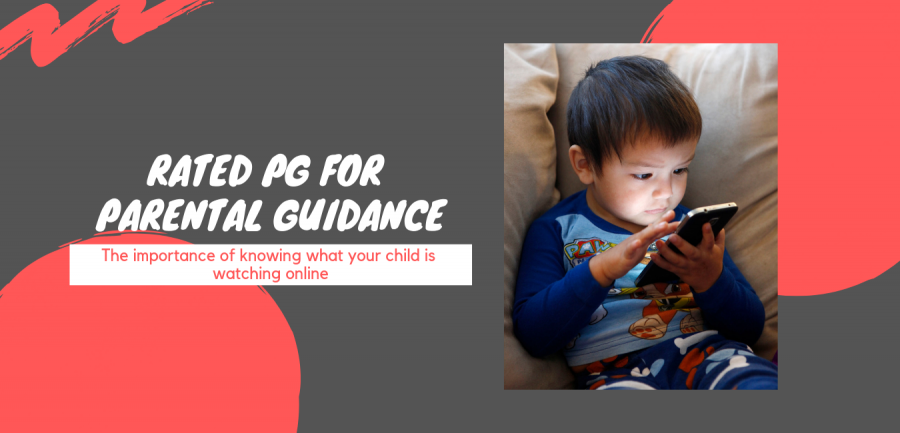Watch what your kids are watching online
‘Momo’ may not be real, but the internet is still a danger zone
Gary Reyes/Bay Area News Group/TNS
Francisco Sanchez Jr., 2, is engrossed in a Ninja Turtle program on YouTube on his parent’s cell phone in Mountain House, Calif.
News channels and social media feeds have been going crazy in recent weeks due to the appearance of the so-called “Momo challenge.” The challenge reportedly aims to get children to hurt themselves, urging victims to perform harmful tasks such as turning on the stove while their parents aren’t home escalating to even take their own lives.
Recent updates on the matter indicate that the challenge was a hoax, and a reoccurring one at that – this exact story spread across local news stations in mid-2018, and it was travelling around Spanish-speaking countries before that. YouTube reported that no videos had been flagged for featuring Momo prior to the outcry, and there were no corroborated reports that any children died thanks to the challenge.
Though the lack of reported injuries is undoubtedly excellent news, it’s not time to celebrate just yet. The Momo challenge is just the latest in a long series of issues with child safety on the internet.
It’s never been a secret that the internet isn’t built for children, as the “don’t talk to strangers” sentiment that’s been prominent offline for decades (if not centuries) quickly translated to the online space. Other people aren’t the only thing to worry about, though, as children left to their own devices can conjure up more than enough more than enough trouble on their own.
Many parents can recall a time in the mid-2000s where they stumbled upon their child watching an episode of “Happy Tree Friends,” a violent, gory adult cartoon starring cute little animals. Though many young adults wear their experiences watching this web-cartoon like a badge of honor, it’s probably the exact kind of content that parents want to shield their young children from. Fortunately, “Happy Tree Friends” can only be found on YouTube proper and not on side-apps like YouTube kids, but there is still danger present.
It can be relaxing to hand your tot a tablet and leave the room to get some “me-time,” but before you dip out of the room, it’s important to make sure you check their playlist. There’s nothing wrong with a few videos from the official Peppa Pig or Sesame Street channels, but unless their parent is diligent, there’s no guaranteeing that that’s all that they’re watching.
The YouTube Kids app caught fire back in 2017 because of a controversy that came to be known as “Elsagate.” Videos began appearing on the service that featured names that children know, such as Santa Claus, Spider-Man, and especially Elsa from Disney’s “Frozen,” but put these characters in situations not suitable for young audiences.
Whether it was characters giving birth, getting a syringe in the rear, taking bloody trips to the dentist, or tearing each other apart, these videos don’t match up tonally with the ones that they attempt to blend in with. Unlike with “Happy Tree Friends,” where Mondo Media made it clear that their shows were made for an older audience, these “Elsagate” videos were aimed at children, appeared on the YouTube Kids app, and had a generally sinister aura surrounding them, with some commentators going as far as to suggest that these videos were made to adhere to certain fetishes.
It’s sickening to think that there are people explicitly targeting children this way, but they do exist and it’s important to take the necessary precautions to make sure your child isn’t affected. One way to ensure that your child is watching safe, kid-friendly content is to stray away from YouTube altogether and move to platforms designed for children.
PBS Kids offers live TV on their website for free, with shows generally deemed to be educational. If your kids are a bit older or you’re just looking for fun distractions, Nickelodeon and Cartoon Network both have apps that are curated to match the user’s personal tastes and are available on multiple devices. If money’s no issue, there are also children’s sections in Netflix and Hulu, each hosting original programming that you can’t get anywhere else.
If you still want to stick with YouTube, though, there is another option: Creating your own personal playlists. YouTube’s autoplay and mix features put you at the mercy of the website’s algorithm, but picking out a couple of videos that you already trust and lining them up for your child gives the power back to you.
YouTube isn’t all bad – in fact, there’s an upcoming Seahawk article that mentions some of the great moves the company has made regarding the spread of anti-vaccination videos – but it does not make for a trustworthy babysitter.







